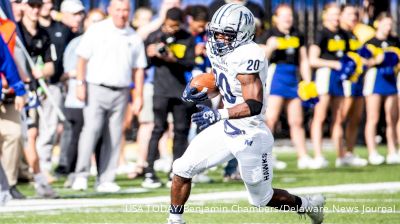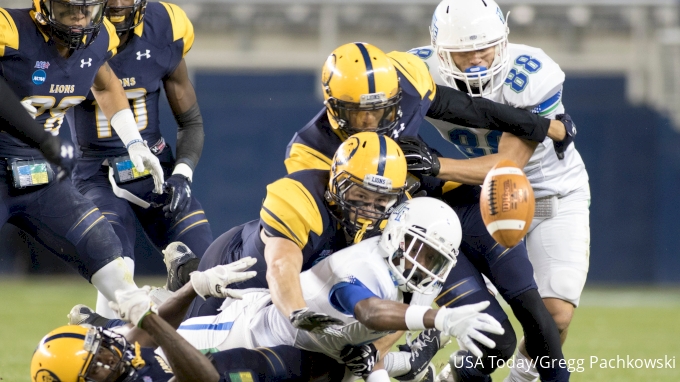How Do The NCAA Division II Football Playoffs Work?
How Do The NCAA Division II Football Playoffs Work?
The NCAA Division II Playoffs have been around for five decades and have become a yearly institution of college football. There's dynasties, stars and more.

- Auto
- 1080
- 720
- 480
- 360
- 136
It’s not quite as gilded or filled with stars as NCAA Division I football, but that’s OK.
For fans of Division II football programs, it’s more than enough – and their division has a great way to decide an annual national champion, too.
The NCAA Division II Football Playoffs have been around for five decades and have become a yearly institution of college football, seeing its share of dynasties, fantastic players and coaches who have gone on to big things at the collegiate and professional levels.
It’s a fun time, but for those who have rarely, or never, checked out Division II football, where do you start?
That’s where FloFootball is here to help, offering a breakdown of all you need to know about how the Division II Playoffs work, long before the festivities get going right before Thanksgiving.
Here’s all you need to know ahead of the 2023 college football season:
What Are The NCAA Division II Football Playoffs?
Officially called the NCAA Division II Football Championship, the division’s annual playoffs will be celebrating their 50th year of existence in 2023 with a 28-team, single-elimination tournament.
The tournament will culminate in the national championship game at the McKinney Independent School District Stadium in McKinney, Texas (located just outside of Dallas) on Dec. 16.
The first round of the playoffs will begin Nov. 18.
What Is The History Of The NCAA Division II Football Playoffs?
The NCAA formed its current three-division system in 1973, and with it came playoff systems for the Division II and Division III levels that put an end to a regional championship/national media poll system that made true “national champions” up for debate.
Now-Division I FBS program Louisiana Tech took home the inaugural Division II national championship that year, emerging victorious after a playoff run that included three wins over other current Division I teams in Western Illinois, Boise State and Western Kentucky – the last of which was a 34-0 rout in front of over 12,000 people at Hughes Stadium in Sacramento, California.
The playoffs have been held every year since, with the exception of 2020, when there was no Division II postseason due to the COVID-19 pandemic.
— D2Football (@D2Football) November 13, 2022
Where Are The NCAA Division II Football Playoffs Played?
Campuses play host during all rounds leading up to the semifinals, with the higher seed in each of the four Super Regions (more on those later on in this article) hosting each matchup.
Once the national semifinals arrive, however, the four remaining teams are re-seeded, with the higher seed in each of those matchups hosting.
Once two teams remain, the national championship is played at a neutral site, which has been the McKinney ISD Stadium in every year the Division II playoffs have been held since 2018.
Braly Municipal Stadium in Florence, Alabama – the home stadium of FCS program North Alabama – has hosted the most Division II national title games, having been the site where the champion was crowned every year from 1986-2013.
How Many Teams Qualify For The NCAA Division II Football Playoffs?
As previously mentioned, 28 teams qualify for the Division II football playoffs.
How Division II decides which teams go to the postseason, however, is through a completely different process than the postseasons of the FCS and Division III.
The Super Region system is unique to Division II, where no conference has an automatic bid to the playoffs, and the postseason places are decided by the top-ranked teams in each of the four Super Regions – groups of conferences (and potentially independents) in a similar geographic area.
A top-10 Super Regional ranking of all the conference’s members in a particular Super Region is released each of the final three weeks of the regular season. At the end, the teams considered by the selection committee to make up the top 7 in each Super Region, qualify for their Super Region’s playoff bracket, where the No. 1 seed receives a first-round bye.
For 2023, Super Region 1 mainly consists of Midwestern/eastern schools, Super Region 2 the southeast, Super Region 3 the Midwest, mid-south and Great Plains and Super Region 4 much of Division II’s northern and western membership, plus Texas.

Who Are The Winningest Teams In NCAA Division II Football Playoffs History?
Northwest Missouri State is the most successful Division II football program in the playoff era, having won six national titles (1998, 1999, 2009, 2013, 2015 and 2016), with the first three coming under the direction of field namesake Mel Tjeersdma, and the latter three under now-Central Oklahoma coach Adam Dorrel.
The Bearcats still are a top-tier Division II program, but other powers in the division are on their tails and trying to catch up.
Grand Valley State, Division II’s team of the 2000s with a four national championship-dynasty from 2002-2006, is ranked No. 3 in the AFCA preseason poll but also stuck in the same league as equally powerful hated rival Ferris State – the two-time reigning and defending national champion.
Valdosta State also has four titles (2004, 2007, 2012 and 2018) and has always-high expectations in the brutal Gulf South Conference.
Funny enough, though, the program closest to NWMSU in Division II titles is a school not even in the division anymore – North Dakota State – best known for another legendary championship dynasty at the FCS level throughout much of the 2010s. NDSU had some of its first tastes of football success in Division II, with a fantastic five-title run from 1983-1990.
Who Are Some Notable Players Who Have Played In The NCAA Division II Football Playoffs?
Players who have starred for their college programs in the Division II Playoffs have gone on to be Super Bowl champions, first-team All-Pros and earn millions of dollars with fruitful professional careers in the NFL, among other accolades.
For instance, Minnesota State in 2012 made a run to the Division II semifinals – the Mavericks’ deepest postseason run in program history (at the time) – off the back of a lethal wide receiver who finished his MSU career at, or near, the top of most all-time program receiving lists.
That player, Adam Thielen, has since made two Pro Bowls with the Minnesota Vikings, broke the NFL record for most consecutive 100-yard receiving games (eight in 2018) and just signed a three-year deal in the offseason with the Carolina Panthers, hoping to show he’s got some stuff left in the tank at the age of 33.
Linebacker Matthew Judon was one of Division II’s most feared pass rushers during his decorated career at Grand Valley State (including a 20-sack season in 2015), before making four Pro Bowls with the Baltimore Ravens and now the New England Patriots.
Then there’s free agent cornerback Malcolm Butler, a former West Alabama standout who helped the Tigers to the playoffs in 2012 and is best known for one of the most iconic plays in football history – intercepting Russell Wilson at the goal line with seconds left to clinch the Patriots a Super Bowl XLIX title.
https://t.co/7sJv27V2os Top 25 Poll@FerrisFootball remains at #1 and @MinesFootball jumps to #2 after a win over @gvsufootball, who falls to #4. @CSUPFootball jumps five places to #20 after an impressive opening season win.https://t.co/VgDtUGVRJT pic.twitter.com/5DgiRJCXlh
— D2Football (@D2Football) September 4, 2023
Who Are The Favorites This Year In NCAA Division II Football?
It’s hard to pick against Ferris State, which received all 29 first-place votes in the American Football Coaches Association preseason Division II poll, as the still-loaded Bulldogs gun for just the second three-peat in the division’s history (North Alabama was the first in the mid-1990s).
But, if there are two other elite teams that can make a statement in the season’s first week, they are No. 2 Colorado School of Mines – last season’s runner-up with the reigning Harlon Hill Trophy winner, quarterback John Matocha – and No. 3 Grand Valley State, mainly because they play each other on Thursday in one of the biggest games you’ll find anywhere in college football this week.
No. 4 Pittsburg State and No. 5 Angelo State, both of whom went 12-1 last year, lurk right behind them, while past national champions Northwest Missouri State and West Florida are No. 6 and No. 7, respectively.